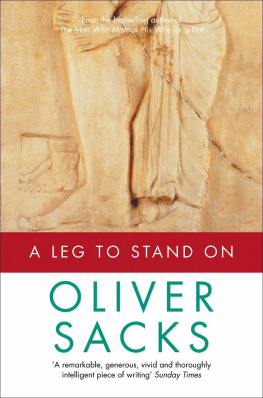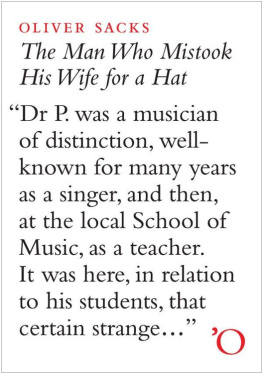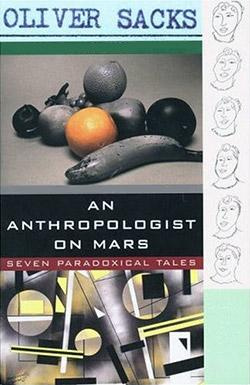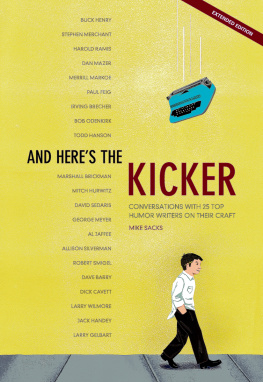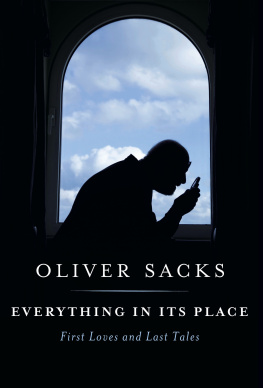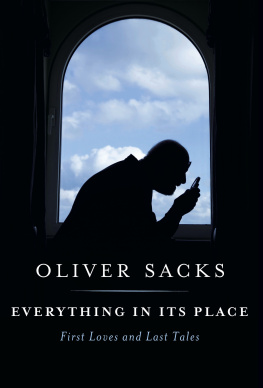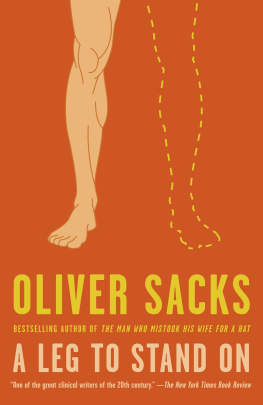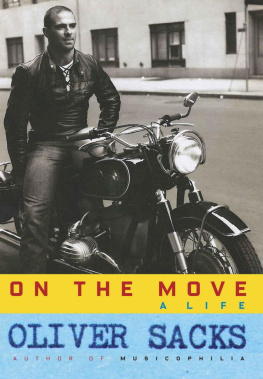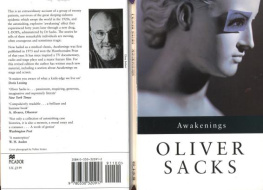A Leg to Stand On
OLIVER
SACKS
PICADOR
Medicine always claims that experience is the test of its operations. Plato therefore was right in saying that to become a true doctor, a man must have experienced all the illnesses he hopes to cure and all the accidents and circumstances he is to diagnose ... Such a man I would trust. For the rest guide us like the person who paints seas, rocks and harbours while sitting at his table and sails his model of a ship in perfect safety. Throw him into the real thing, and he does not know where to begin. |
Montaigne, Essays 3.13 |
Preface
Thom Gunn has written powerfully of the occasions of poetry. Science has its occasions no less than art: sometimes a dream-metaphor, like Kekuls snakes; sometimes an analogy, like Newtons apple; sometimes a literal event, the thing-in-itself, which suddenly explodes into unimagined significance, like Archimedes Eureka! in his bath. Every such occasion is a eureka or epiphany.
The occasions of medicine are provided by sickness, injury, patients. The occasion of this book was a peculiar injury, or at least an injury with peculiar effects, resulting from an accident on a mountain in Norway. A physician by profession, I had never found myself a patient before, and now I was at once physician and patient. I had imagined my injury (a severe but uncomplicated wound to the muscles and nerves of one leg) to be straightforward and routine, and I was astonished at the profundity of the effects it had: a sort of paralysis and alienation of the leg, reducing it to an object which seemed unrelated to me; an abyss of bizarre, and even terrifying, effects. I had no idea what to make of these effects and entertained fears that I might never recover. I found the abyss a horror, and recovery a wonder; and I have since had a deeper sense of the horror and wonder which lurk behind life and which are concealed, as it were, behind the usual surface of health.
Deeply disturbed and puzzled by these singular effects the central resonances, so to speak, of a peripheral injury and the absence of adequate reassurance from my own doctor, I wrote to the eminent neuropsychologist A.R. Luria in Moscow. In the course of his reply he wrote: Such syndromes are perhaps common, but very uncommonly described. When I recovered from my injury and returned to being a doctor, I found that this was indeed the case. Over the years I investigated some hundreds of patients, all with singular disorders of body-image and body-ego which were neurologically determined and essentially similar to my own. I discuss this work and its implications in outline in the last chapter of this book. I hope to publish a detailed monograph on the subject later.
Thus many themes are interwoven here: the specific neuropsychological and existential phenomena associated with my injury and recovery; the business of being a patient and of returning later to the outside world; the complexities of the doctor-patient relationship and the difficulties of dialogue between them, especially in a matter which is puzzling to both; the application of my findings to a large group of patients, and the pondering of their implication and meaning all this leading, finally, to a critique of current neurological medicine, and to a vision of what may be the neurological medicine of the future.
This last did not come till several years later. Its occasion was a long train-ride from Boston to New York, when I read Henry Heads great Studies in Neurology (1920): his journey so similar to my own, from the examination of the effects of a cut nerve in himself to the most general concepts of body-image and body-music. My final chapter was written on a mountain in Costa Rica, completing the odyssey begun on that fateful mountain in Norway.
Except in the last chapter the material is not presented systematically. The book may be regarded as a sort of neurological novel or short story, but one which is rooted in personal experience and neurological fact, such as Luria has given us in The Man with a Shattered World, and his other neurographies.
In all this I was greatly assisted and encouraged by Luria, with whom I had the privilege of an intimate correspondence from 1973 until his death in 1977. In the course of our correspondence he wrote: You are discovering an entirely new field ... Please publish your observations. It will do something to alter the veterinary approach to peripheral disorders, and to open the way to a deeper and more human medicine. To the late A.R. Luria, the pioneer of a new and deeper medicine, I dedicate this book in grateful memory.
London & New York
O.W.S.
I. The Mountain
This world of limitless silences had nothing hospitable; it received the visitor at his own risk, or rather it scarcely even received him, it tolerated his penetration into its fastnesses in a manner that boded no good: it made him aware of the menace of the elemental, a menace not even hostile, but impersonally deadly. |
Thomas Mann, The Magic Mountain |
The Mountain
Saturday the 24th started overcast and sullen, but there was promise of fine weather later in the day. I could start my climb early, through the low-lying orchards and woods, and by noon, I reckoned, reach the top of the mountain. By then, perhaps, the weather would have cleared, and there would be a magnificent view from the summit the lower mountains all around me, sweeping down into Hardanger fjrd, and the great fjrd itself visible in its entirety. Climb suggests scaling rocks, and ropes. But it was not that sort of climb, simply a steep mountain path. I foresaw no particular problems or difficulties. I was as strong as a bull, in the prime, the pride, the high noon of life. I looked forward to the walk with assurance and pleasure.
I soon got into my stride a supple swinging stride, which covers ground fast. I had started before dawn, and by half past seven had ascended, perhaps, to two thousand feet. Already the early mists were beginning to clear. Now came a dark and piney wood, where the going was slower, partly because of knotted roots in the path and partly because I was enchanted by the world of tiny vegetation which sheltered in the wood, and was always stopping to examine a new fern, a moss, a lichen. Even so, I was through the woods by a little after nine, and had come to the great cone which formed the mountain proper and towered above the fjrd to 6,000 feet. To my surprise there was a fence and a gate at this point, and the gate bore a still more surprising notice:
BEWARE OF THE BULL!
in Norwegian, and for those who might not be able to read the words, a rather droll picture of a man being tossed.
I stopped, and scrutinised the picture and scratched my head. A bull? Up Here? What would a bull be doing up here? I had not even seen sheep in the pastures and farms down below. Perhaps it was some sort of joke, tacked there by the villagers, or by some previous hiker with an odd sense of humour. Or perhaps there was a bull, summering amid a vast mountain pasture, subsisting on the spare grass and scrubby vegetation. Well, enough of speculation! Onwards to the top! The terrain had changed again. It was now very stoney, with enormous boulders here and there; but there was also a light topsoil, muddy in places because it had rained in the night, but with plenty of grass and a few scanty shrubs fodder enough for an animal which had the whole mountain to graze. The path was much steeper and pretty well marked though, I felt, not much used. It was not exactly a populous part of the world. I had seen no visitors apart from myself, and the villagers, I imagined, were too busy with farming and fishing, and other activities, to go jaunting up the local mountains. All the better. I had the mountain to myself! Onwards, upwards though I could not see the top, but I had already ascended, I judged, 3,000 feet, and if the path ahead was simply steep, but not tricky, I could make the top by noon, as I had planned. And so I forged ahead, keeping up a brisk pace despite the gradient, blessing my energy and stamina, and especially my strong legs, trained by years of hard exercise and hard lifting in the gym. Strong quads, strong body, good wind, good stamina I was grateful to Nature for endowing me well. And if I drove myself to feats-of-strength, and long swims, and long climbs, it was a way of saying Thank you to Nature and using to the full the good body she had given me. Around eleven oclock, when the shifting mists allowed, I had my first glimpses of the mountain top not so far above me I
Next page
